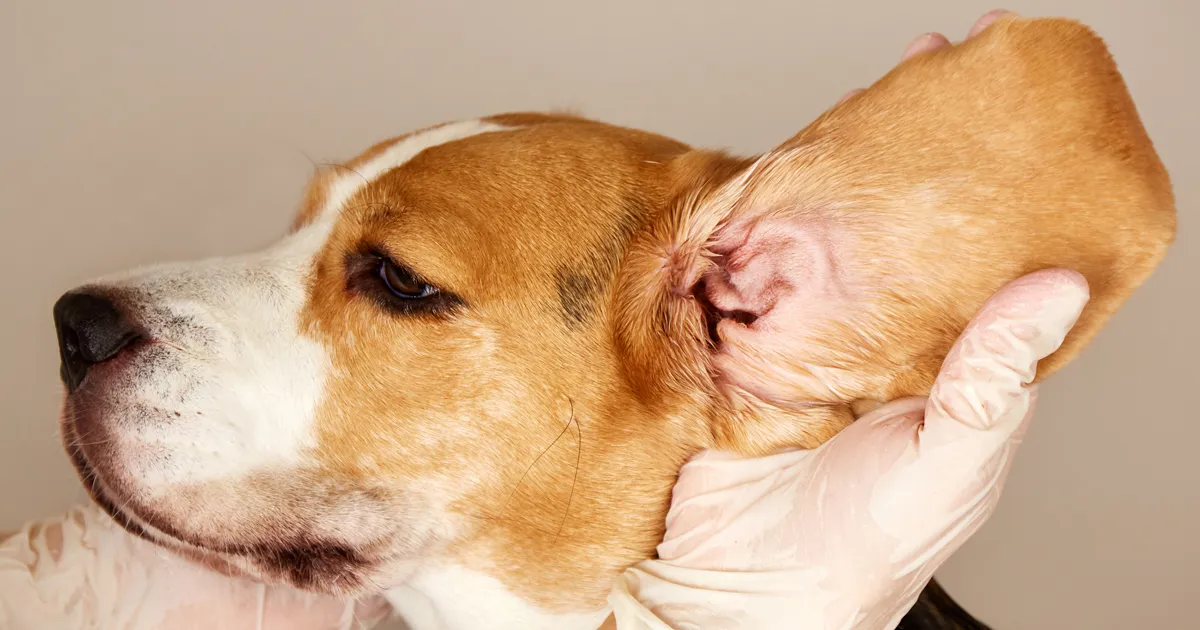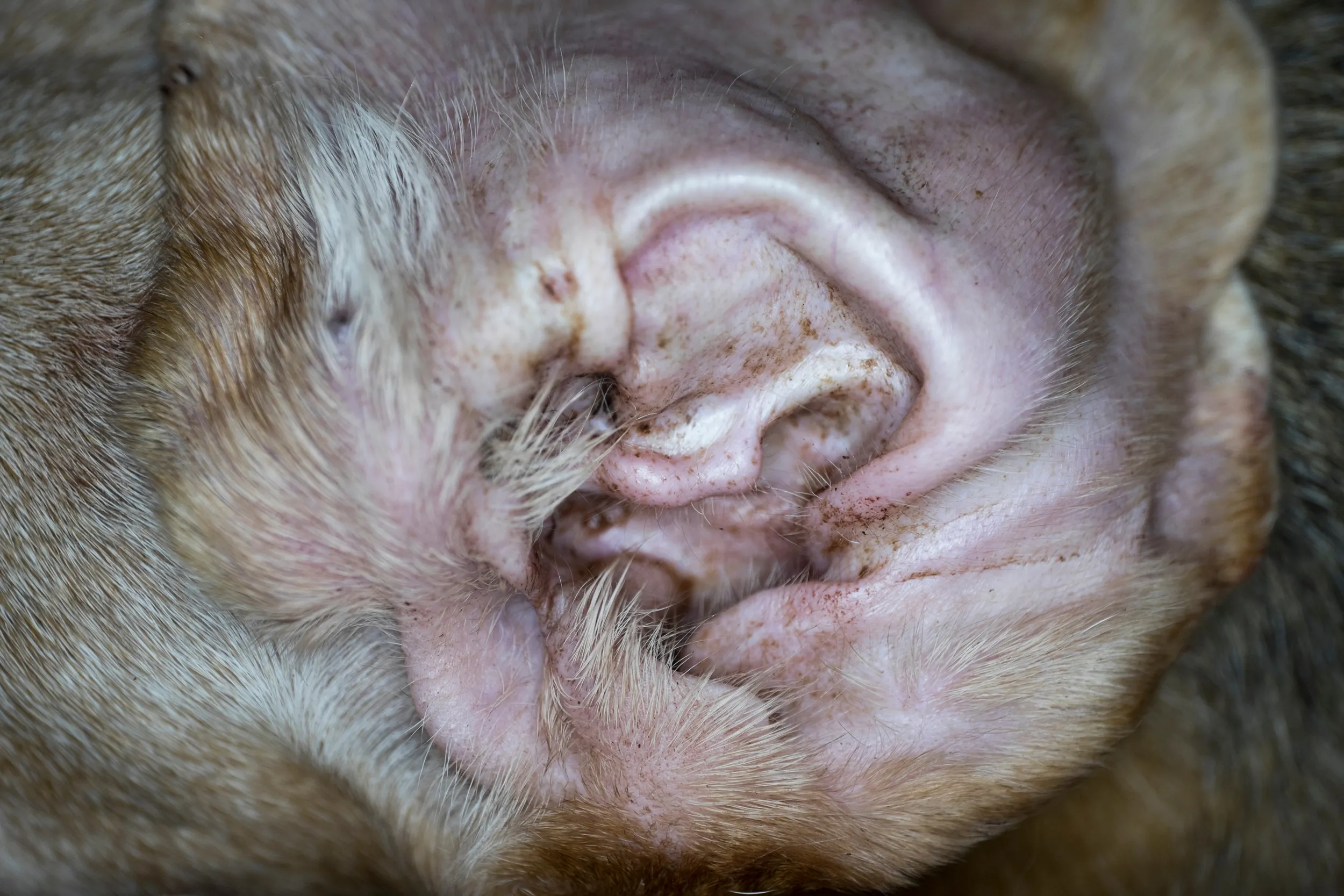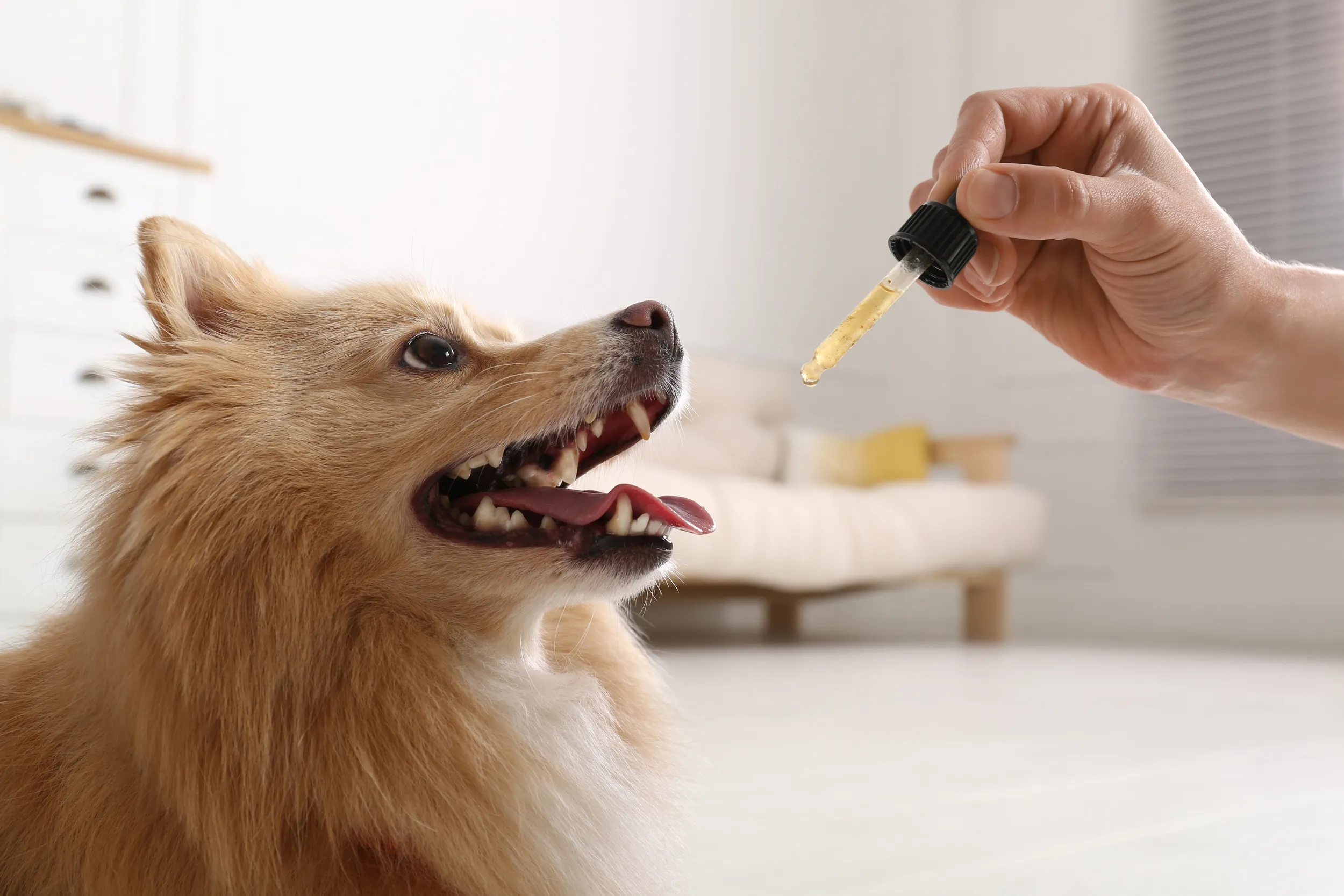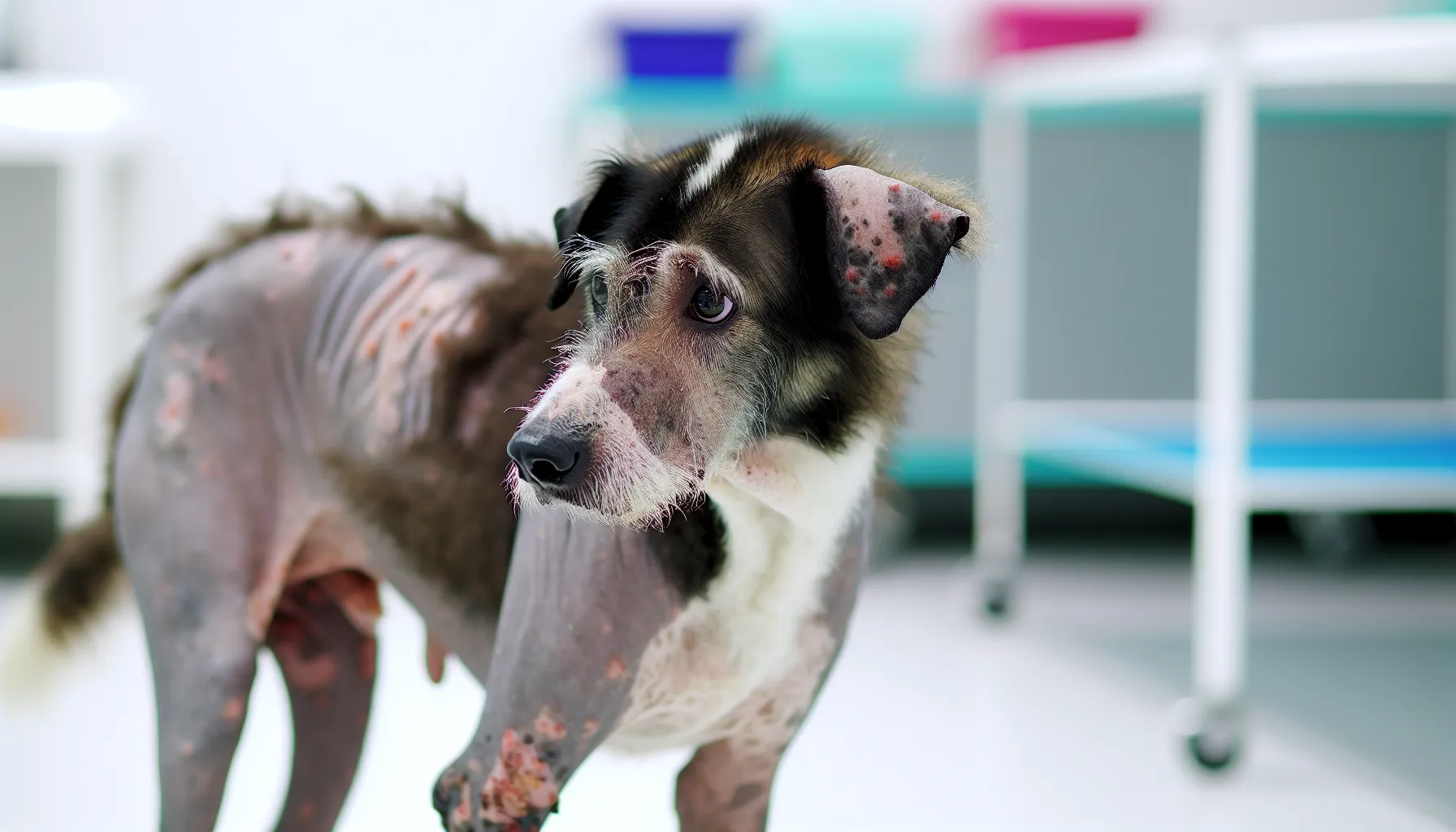Mites are unwelcome microscopic parasites that can cause significant discomfort and health issues for our beloved canine companions. Identifying, treating, and preventing these infestations are crucial steps for every responsible pet owner. This detailed guide, presented by Dog Care Story, delves into effective strategies for managing mites, with a particular focus on safe and practical At Home Treatment For Mites On Dogs. We aim to equip you with the knowledge to protect your dog, ensuring their health and comfort.
Scratching, hair loss, and skin irritation are classic indicators that your dog might be battling a mite infestation. Understanding the different types of mites, recognizing their symptoms, and knowing how to combat them, particularly through accessible home remedies, is essential. Let’s explore the various aspects of dog mites, from their identification and diagnosis to effective treatment protocols and prevention strategies, all tailored to empower pet owners in the English-speaking market.
Key Takeaways for At Home Treatment for Mites on Dogs
- Dogs can acquire mites through direct contact with infested animals or contaminated environments. Common types include Demodex canis (follicle mites) and Cheyletiella (causing ‘walking dandruff’).
- Symptoms of a mite infestation often include excessive scratching, hair loss, skin inflammation, and, in the case of ear mites, a dark, waxy discharge with an unpleasant odor. Early recognition is key for timely intervention.
- While veterinary consultation is always recommended, effective at home treatment for mites on dogs can include natural remedies like olive oil, garlic oil, and green tea, which help alleviate symptoms and eliminate parasites. Prevention involves regular cleaning, immune system support, and minimizing exposure to sources of infestation.
What Are Dog Mites? Understanding the Enemy
 Microscopic Ear Mites On A Dog
Microscopic Ear Mites On A Dog
Mites are tiny arachnids, close relatives of spiders and ticks, that are ubiquitous in various environments and known to infest a wide range of mammalian hosts, including our canine friends. To the naked eye, these parasites appear as minuscule white dots, if visible at all. Their life cycles typically span 17 to 35 days, evolving through egg, larva, nymph, and adult stages.
The primary mites responsible for skin diseases in dogs are:
- Sarcoptes scabiei: Causes sarcoptic mange (scabies).
- Otodectes cynotis: Responsible for ear mite infestations.
- Demodex canis: Known as follicle mites, leading to demodectic mange.
- Cheyletiella spp.: The cause of ‘walking dandruff.’
Demodex canis mites, often called follicle mites, live within a dog’s hair follicles and sebaceous glands. These mites are naturally present in most dogs and usually cause no issues unless their population grows excessively due to a weakened immune system. Transmission primarily occurs during early puppyhood from the mother dog to her pups while nursing. Understanding this natural presence and the conditions that lead to overpopulation is vital for effective management and knowing when intervention, potentially an at home treatment for mites on dogs, becomes necessary.
Conversely, Cheyletiella spp. mites, which cause ‘walking dandruff,’ complete their entire life cycle on the host’s skin surface. This results in noticeable dandruff-like flakes. Recognizing these different types of mites and their behaviors is fundamental to identifying an infestation and choosing the most appropriate treatment path.
Recognizing the Signs: Symptoms of Mites on Dogs
 Photo Of A Dog Scratching Its Ear
Photo Of A Dog Scratching Its Ear
Dogs affected by mite infestations commonly display a range of symptoms, indicating irritation and discomfort. Prompt identification of these signs is crucial for early intervention, including initiating an at home treatment for mites on dogs or seeking veterinary advice.
General symptoms of dog mite infestations often include:
- Excessive Scratching: A primary indicator of intense itching and irritation.
- Hair Loss (Alopecia): Can be patchy or widespread, depending on the mite type and severity.
- Redness or Inflammation of the Skin (Erythema): Affected areas often appear irritated and red.
- Sores or Scabs: Resulting from continuous scratching and skin trauma.
- Itching or Discomfort: Observable through restlessness or visible agitation.
- Ear Infections or Discharge: Particularly indicative of ear mites.
- Thickened or Crusted Skin (Lichenification): A chronic skin response to irritation.
- Bad Odor: Often associated with secondary bacterial or yeast infections.
The specific presentation of symptoms can vary significantly based on the type of mite involved. It is essential to observe these signs closely. If you notice any of these indicators in your dog, it’s advisable to consult a veterinarian for an accurate diagnosis and to discuss potential treatment strategies, including viable options for at home treatment for mites on dogs. For those interested in recognizing symptoms, understanding the early signs of ear mites in dogs can be particularly helpful.
Let’s delve deeper into the specific signs associated with ear mites and skin mites.
Ear Mites: Telltale Signs
 Closeup Of Ear Mites In A Dog
Closeup Of Ear Mites In A Dog
Ear mites (Otodectes cynotis) are a widespread issue, primarily residing on the skin surface within a dog’s ear canal. These tiny parasites cause severe irritation, often leading to otitis externa, an inflammation of the external ear canal. Dogs suffering from ear mites typically exhibit intense scratching around their ears, head, and neck, along with frequent head shaking.
The most distinctive symptom of ear mites is a dark, waxy discharge resembling coffee grounds, which often emits a strong, unpleasant odor from the dog’s ears. If your dog frequently shakes its head, scratches its ears excessively, and you observe this characteristic discharge, it’s a strong indication to visit your vet for a mite check. This also helps rule out other ear infections that might present similarly. For deeper insights into this specific issue, explore why ear mites in dogs can humans get it.
Skin Mites: Identifying the Irritations
Skin mites can manifest in several ways, causing various forms of mange. These conditions range in severity and contagiousness, making accurate identification vital for effective at home treatment for mites on dogs or professional intervention.
Sarcoptic Mange (Scabies)
Caused by Sarcoptes scabiei var canis, sarcoptic mange is characterized by intense itching, hair loss, and skin inflammation. These mites burrow into the outer layer of the skin, leading to secondary infections from persistent scratching. The intense pruritus (itching) can result in painful wounds. Sarcoptic mites are highly contagious, spreading easily between dogs and even to humans (though human infestations are typically self-limiting).
Cheyletiellosis (‘Walking Dandruff’)
Other skin mites, such as those causing cheyletiellosis, lead to significant skin scaling, particularly along the dog’s back. This condition is often referred to as “walking dandruff” because the mites and their debris can be seen moving on the fur.
Demodectic Mange (Demodicosis)
Localized or generalized demodicosis, caused by an overgrowth of Demodex canis mites, can present as hairless, red, scaly skin patches, sometimes resembling acne. While often not itchy, secondary bacterial infections can lead to significant discomfort.
Canine Scabies
Canine scabies can also cause small, solid bumps (papules) and thick, crusted sores, all exacerbated by persistent scratching. These varied presentations highlight the importance of careful observation.
Additional Health Conditions Caused by Dog Mites
Beyond the primary skin and ear issues, mite infestations can lead to a cascade of related health problems if left untreated. Recognizing these can guide your approach to comprehensive care, including the application of at home treatment for mites on dogs.
- Sarcoptic Mange (Scabies): Highly contagious, leading to severe itching, redness, and potential secondary bacterial infections from scratching.
- Demodectic Mange: Can be localized (patchy baldness) or generalized (widespread bald spots, often with secondary infections).
- Cheyletiellosis (‘Walking Dandruff’): Characterized by large, scaly skin flakes and mild to moderate itching.
- Trombiculosis (Harvest Mite Infestation): These mites, typically found in grassy areas, cause intense itching and discomfort, often seen seasonally.
- Ear Mites: Living in the ear canals, they lead to severe discomfort, head shaking, and potential secondary ear infections.
Identifying and treating mite infestations early is paramount to prevent severe discomfort, spread to other pets, and the development of secondary infections. Regular check-ups and maintaining a clean environment significantly aid in managing and preventing these conditions.
How Dogs Get Mites: Understanding Transmission
Dogs primarily acquire mites through direct contact with another infested animal or through contaminated environments. This includes exposure to infested bedding, grooming tools, or shared surfaces. For instance, canine scabies mites can be transmitted indirectly via shared items, highlighting the need for thorough environmental cleaning. Certain mites, like Cheyletiella, are quite resilient and can survive for up to 10 days in the environment, making comprehensive treatment of a pet’s living area crucial to prevent re-infestation.
Older dogs and those with compromised or weakened immune systems are at a higher risk of developing a mite infestation. Their reduced ability to fight off parasites means that even naturally occurring mites like Demodex can proliferate and cause problems. Therefore, minimizing exposure to potentially infested animals or environments and actively supporting your dog’s immune health are essential preventive measures.
Diagnosing Mites in Dogs: The Path to Treatment
 Mites On Dog Senior Dog Laying On Owners Bed
Mites On Dog Senior Dog Laying On Owners Bed
Accurate diagnosis is the cornerstone of effective mite treatment. While some visible signs might suggest mites, veterinary techniques are essential to confirm the presence of specific mite types. Common mites like Sarcoptes, Demodex, and Cheyletiella are typically diagnosed through skin scraping techniques. A small amount of mineral oil is applied to the affected skin, and then a sterile blade is used to gently scrape the surface, collecting skin debris and mites for microscopic examination.
- Demodex Mites: Because these mites reside deep within hair follicles, deep skin scrapings are required to reach them.
- Sarcoptes Mites: These mites are less abundant on the skin surface and are notoriously difficult to find. Veterinarians often perform multiple superficial scrapings, as false negatives are common. In many cases, treatment is initiated based on clinical signs and a presumptive diagnosis if mites aren’t found.
- Cheyletiella Mites: These surface-dwelling mites can be identified using wide superficial scrapings or by pressing clear acetate tape onto scaly areas, which is then examined under a microscope.
- Ear Mites: Diagnosis involves using an otoscope to examine the ear canals. A sample of the ear discharge is also collected and examined under a microscope to confirm the presence of Otodectes cynotis.
An accurate diagnosis is vital before starting any treatment, including any at home treatment for mites on dogs, to ensure the chosen method is appropriate and safe for the specific type of mite infestation.
Treatment Options to Get Rid of Mites on Dogs: A Balanced Approach
Addressing mite infestations requires a comprehensive approach, combining professional veterinary care with supportive at home treatment for mites on dogs. Various options are available, ranging from conventional medications to natural home remedies. The best course of action depends on the severity of the infestation, the dog’s overall health, and the owner’s preferences, always in consultation with a veterinarian.
Side Effects of Conventional Mite Treatments
Conventional treatments often involve oral pesticides, injectables, and topical medications. While effective, many of these drugs work by paralyzing the parasites, which can sometimes pose risks to your dog, as they often contain neurotoxins. It’s crucial to be aware of potential side effects and discuss them thoroughly with your vet.
Common side effects of conventional mite treatments can include:
- Neurological Issues: Tremors, seizures, ataxia (incoordination).
- Gastrointestinal Distress: Vomiting or diarrhea, loss of appetite.
- Dermatological Reactions: Skin irritations, redness, or itching at the application site.
- General Malaise: Lethargy, weakness.
Considering these potential side effects and the fact that many conventional medications target only adult mites (not eggs), exploring safer, gentler, and complementary solutions for at home treatment for mites on dogs becomes highly appealing. For those looking for quick solutions, it’s worth noting that options exist for over the counter mite treatment for dogs.
3 Natural Home Remedies for At Home Treatment for Mites on Dogs
 Mites On Dogs Natural Remedies For Ear Mites
Mites On Dogs Natural Remedies For Ear Mites
Natural solutions offer a gentler and often safer approach to support the elimination of mites in dogs, especially as part of an at home treatment for mites on dogs regimen. These remedies can help alleviate discomfort and target mites without the harsh chemicals found in some conventional treatments.
1. Olive Oil for Mite Suffocation
Olive oil is a popular natural remedy due to its ability to help suffocate mites, especially ear mites, and to loosen waxy debris. Its gentle nature makes it suitable for sensitive areas.
- Application: Using a clean cotton ball or soft cloth, gently clean the affected ear(s) with pure olive oil. For skin mites, apply a thin layer to localized irritated patches.
- Action: Olive oil works by coating the mites, blocking their breathing pores, and ultimately suffocating them. It also helps to break down and remove the dark, waxy discharge often associated with ear mites.
- Frequency: Repeat the treatment every 3 days for at least 2 weeks. Mite eggs hatch approximately every 4 days, so this consistent application schedule is crucial to target newly hatched mites and prevent proliferation.
- Important Note: Always ensure the olive oil is at room temperature. Never pour cold oil into a dog’s ear.
- Bonus: Essential Oil Boost: To enhance the treatment and aid recovery, you can add 1-3 drops of a single, high-quality essential oil per 30ml of olive oil.
- Peppermint: Acts as a natural anesthetic, helping to soothe itching.
- Catnip: Contains compounds that can help control mite populations.
- St. John’s Wort: Known for its pain-relieving properties, beneficial for very irritated skin.
- Calendula: Promotes healing of the delicate ear skin and reduces inflammation.
- Caution: Always perform a patch test first to ensure your dog does not have an adverse reaction to essential oils. Use therapeutic-grade oils and consult your vet before use, especially for pregnant or very young animals.
2. Garlic Oil: Natural Anti-Parasitic and Soother
Garlic oil is often endorsed by herbal practitioners for its natural sulfur content, which acts as a natural mite repellant and an effective anti-parasitic agent. Furthermore, garlic’s well-known antibacterial and anti-fungal properties make it beneficial in treating any secondary infections that often accompany mite infestations.
- Preparation: Mince two cloves of fresh garlic and immerse them in approximately one cup (240ml) of olive oil. Allow this mixture to infuse overnight at room temperature.
- Straining: The following day, strain out the garlic cloves to obtain the infused oil. Transfer the oil into a clean glass jar for storage.
- Application: Using a dropper, administer the garlic oil into your dog’s affected ear(s) or apply to skin patches, applying it twice a day.
- Duration: Continue this application for several weeks, or as advised by your veterinarian, to ensure all mite life stages are eradicated.
- Safety Note: While topical garlic oil is generally considered safe, ensure your dog does not ingest large quantities. Oral garlic in large doses can be toxic to dogs.
3. Green Tea: Antiseptic Cleanser
Green tea is not only a refreshing beverage but also a potent natural antiseptic. It can effectively help eliminate all life stages of dog mites and is particularly useful for clearing the brown, waxy discharge often seen with ear mites.
- Preparation: Place one green tea bag or one tablespoon of loose green tea into a cup of boiling water. Allow it to steep for several minutes before straining the tea leaves.
- Cooling: Let the tea cool completely to room temperature. It is crucial that the tea is not hot when applied.
- Application: Using a dropper, add 3-4 drops of the cooled green tea into each affected ear. Gently massage the base of your dog’s ears to help distribute the tea.
- Cleaning: Moisten a separate cotton ball with the green tea and gently wipe away any interior ear wax and debris from each ear.
- Frequency: Repeat this process daily for a duration of 4 weeks. Consistency is key for comprehensive mite eradication.
- Benefits: The natural antioxidants and anti-inflammatory compounds in green tea also help soothe irritated skin and promote healing.
These effective at home treatment for mites on dogs options can provide significant natural relief and help manage infestations. However, it’s always advisable to combine these with preventive measures to minimize future risks.
Preventing an Infestation of Dog Mites: Proactive Care
Prevention is undeniably superior to cure, particularly when it comes to parasitic infestations in dogs. Dogs can easily contract mites, making consistent preventive measures crucial. Integrating good hygiene practices with a strong focus on immune health is the best defense.
Hygiene and Environmental Management
- Regular Ear Cleaning: Gently cleaning your dog’s ears regularly with a damp cloth can help prevent mite build-up. However, avoid over-cleaning, as this can disrupt the natural balance of healthy ear bacteria.
- Bedding and Environment: Thoroughly wash your dog’s bedding, toys, and any areas they frequent in hot water. Mites can survive off-host for several days, so environmental decontamination is vital to prevent re-infestation.
- Grooming Tools: Regularly clean and disinfect grooming brushes, combs, and clippers, especially if used on multiple pets.
Strengthening the Immune System
A robust immune system is fundamental for dogs to naturally ward off parasites, including mites. This reduces susceptibility to infestations and can enhance the effectiveness of any at home treatment for mites on dogs.
- Premium Diet: Provide your dog with the finest diet of whole foods, opting for raw or lightly cooked meals that are within your budget. A nutrient-rich diet supports overall health and immune function.
- Avoid Over-Vaccination: Discuss appropriate vaccination schedules with your vet to avoid unnecessary immune stress.
- Minimize Chemical Exposure: Avoid unnecessary antibiotics, pharmaceutical drugs, and topical pesticides. Minimize the presence of chemicals in your dog’s living environment, including chemical-based lawn treatments and fertilizers, which can weaken immune defenses.
- Supplements: Consider supplements like probiotics and prebiotics to support gut health, which is intricately linked to immune function.
Direct Preventive Measures
In addition to general health and hygiene, specific actions can further reduce the risk of mite infestation:
- Limit Contact: Ensure your dog doesn’t come into direct contact with unfamiliar dogs or feral animals who might be infested. While sometimes tricky, vigilance is key, especially in dog parks or communal areas.
- Post-Treatment Hygiene: If your dog has been treated for mites (either conventionally or with at home treatment for mites on dogs), thoroughly wash all their bedding, toys, and clean their surroundings to eliminate any lingering mites or eggs and prevent re-infestation.
- Isolation: If one dog in a multi-pet household is diagnosed with mites, it’s advisable to keep them isolated from other pets until they have been fully treated and cleared by a veterinarian to stop the spread.
- Feline Contact: Keeping dogs away from outdoor or feral cats can reduce the risk of ear mite exposure, as cats are common carriers of Otodectes cynotis.
By combining these lifestyle practices with specific preventive measures, you can significantly reduce the risk of your dog suffering from mites, fostering a healthier, happier life for your furry friend.
Mites on Dogs: Debunking Myths and Misconceptions
Understanding common myths and misconceptions about mites can prevent unnecessary panic and ensure appropriate action, whether it’s through at home treatment for mites on dogs or veterinary intervention.
One widespread misconception is that humans can contract the same severe form of scabies from dogs as they do from other humans. While sarcoptic mites (Sarcoptes scabiei) can temporarily infest humans, causing itchy red bumps, the condition is usually self-limiting. The mites cannot complete their life cycle on humans and therefore do not result in the deep burrows or chronic condition seen in typical human scabies.
Another myth is that ear mites (Otodectes cynotis) from dogs commonly affect humans. In reality, these specific types of dog mites rarely infest humans. Generally, mites are species-specific, preferring one host over another. However, some, like sarcoptic mites, can cross over to humans if there’s close contact, causing temporary discomfort. For pet owners concerned about how to evade contracting mange from pets and control mite infestations in the household, consulting both veterinarians and doctors is vital. This collaborative approach helps clarify the risks and ensure both pet and human health are protected.
Mite Infestations in Multi-Pet Households: A Coordinated Approach
 Mite treatment for dogs pets at home
Mite treatment for dogs pets at home
Managing an infestation of mites in multi-pet households presents a unique challenge, as the risk of transmission and re-infestation is significantly higher. When one pet is diagnosed with mites, it is generally crucial to treat all pets in the household, even if they show no symptoms, to prevent them from reinfecting each other and to achieve complete eradication of the parasites. This coordinated approach is vital for any mite treatment for dogs pets at home.
To effectively prevent the transmission of mites between pets, consider the following strategies:
- Avoid Contact with Infected Animals: Limit interaction between your pets and any animals suspected or confirmed to have mites. This includes neighborhood pets or animals encountered in public spaces.
- Quarantine Affected Pets: If a pet is diagnosed with mites, temporarily separate them from other pets in the household until they have completed their treatment and are confirmed mite-free by a veterinarian. This prevents direct transmission.
- Treat All Close-Contact Animals: As mites are highly contagious, especially sarcoptic and cheyletiella mites, all animals in close contact—including dogs, cats, and other domestic pets—should undergo treatment. This proactive measure ensures that no hidden carriers remain to perpetuate the infestation cycle.
- Environmental Disinfection: Alongside treating the animals, thoroughly clean and disinfect the entire living environment, including bedding, toys, carpets, and furniture. Mites can survive off-host for varying periods, making environmental control a critical step.
- Regular Monitoring: Even after treatment, continue to monitor all pets for any recurring symptoms. Regular grooming and skin checks can help catch any new infestations early.
Taking these precautions diligently is crucial for effectively managing and eradicating mite infestations in a multi-pet household. It underscores the importance of a holistic approach to parasite control, which also extends to comprehensive flea tick and intestinal worm treatment for dogs for overall parasite prevention.
Summary: Your Guide to Mite-Free Living
Dealing with mites in dogs can be a formidable challenge, but with accurate information and a proactive approach, we can effectively diagnose, treat, and prevent these bothersome infestations. We’ve explored the various types of mites, their life cycles, and the specific diseases they cause, providing a foundational understanding for pet owners. Crucially, we’ve delved into recognizing the signs and symptoms, understanding diagnostic methods, and implementing treatment strategies that encompass both conventional options and highly effective at home treatment for mites on dogs.
Prevention remains the cornerstone of keeping our dogs mite-free. This involves a multi-faceted approach: regular ear cleaning, nurturing a strong immune system through optimal nutrition, minimizing exposure to environmental chemicals, and limiting contact with potentially infested animals. Moreover, debunking common myths and misconceptions empowers us to make informed decisions without undue anxiety.
In wrapping up our comprehensive exploration, it’s evident that prevention and early intervention are paramount. Integrating supplements that support digestive health and nutrient absorption, such as probiotics and prebiotics, can significantly contribute to your dog’s immune strength, forming a critical line of defense against mite infestations. A robust immune system helps deter mite proliferation by making your dog a less hospitable host for these opportunistic parasites. Remember, our pets rely on us for their health and well-being. By staying informed and proactive, we can do all we can to keep your furry friend safe, comfortable, and happy.
Frequently Asked Questions
How do I know if my dog has mites?
If your dog has mites, you may observe intense itching, sudden or patchy hair loss, skin inflammation, and dandruff. For ear mites, a dark, waxy discharge resembling coffee grounds in the ears is a common sign. Close observation of these symptoms, especially if persistent, warrants a veterinary check-up to confirm the diagnosis and discuss the best course of action, which might include an at home treatment for mites on dogs.
What is Cheyletiellosis?
Cheyletiellosis, colloquially known as “walking dandruff,” is a skin condition caused by an infestation of Cheyletiella mites. These mites are large enough to be occasionally seen by the naked eye and derive their nickname from the appearance of dandruff-like flakes that seem to move on the skin of affected animals.
Symptoms and Signs
- Dandruff Appearance: The most distinctive symptom is the presence of white, flaky scales on your pet’s coat, often most visible along the back.
- Mild Itching: Unlike other mite infestations, cheyletiellosis may not always cause severe itching unless your pet develops a hypersensitivity reaction to the mites.
- Contagious: This condition is highly contagious and can easily spread between dogs, other animals (like cats and rabbits), and can even cause temporary itching in humans.
Diagnosis and Treatment
Veterinarians typically diagnose cheyletiellosis through various methods, including skin scrapings, careful examination of the fur, or using adhesive tape to capture mites for microscopic examination. Treatments usually involve:
- Topical Medications: Mite-killing shampoos, dips, or spot-on treatments.
- Oral Medications: In some cases, oral parasiticides may be prescribed by a vet.
- Environmental Cleaning: Thorough cleaning and treatment of the pet’s living area are essential to prevent re-infestation due to mites surviving in the environment.
Prevention
Regular grooming practices, routine veterinary check-ups, and limiting contact with potentially infested animals can help catch infestations early and reduce the risk of spreading mites to other pets and humans. Understanding cheyletiellosis helps pet owners proactively ensure their furry friends remain healthy and comfortable, complementing any at home treatment for mites on dogs with broader parasite control.
What Are Harvest Mites?
Harvest mites, also known as chiggers or Trombiculidae, are tiny arachnids that typically inhabit grassy fields, woodlands, and gardens. These mites are especially prevalent during the late summer and early autumn months. Both pets and humans can become hosts to these pests, often acquiring them during outdoor activities in rural or vegetated environments.
Key Facts About Harvest Mites:
- Size and Appearance: Harvest mites are minuscule, making their larvae (the parasitic stage) difficult to spot with the naked eye. They are usually red or orange and can appear as tiny specks on the skin, often clustered together.
- Affecting Various Species: While dogs are commonly affected, cats, humans, and other mammals can also be targets for these mites.
- Symptoms in Hosts:
- Persistent and intense itching, often localized.
- Small, red bumps (papules) or crusts on the skin.
- Inflammation and discomfort, particularly in areas of thin skin like ears, paws, and abdomen.
Common Time Frame: These mites are most active from mid-summer through early autumn (July to October), making this the peak period for potential exposure. Understanding where and when these mites are most active helps in taking preventive measures and considering specific at home treatment for mites on dogs if an infestation occurs.
How do you get rid of mites on a dog?
To get rid of mites on a dog, a combination of approaches is often necessary. This typically includes using medicated shampoos, dips, or spot-on treatments prescribed or recommended by a veterinarian. In more severe cases, prescription oral medications or injectables may be needed. Supporting these with an at home treatment for mites on dogs, such as regular olive oil or green tea applications for ear mites, can provide relief and aid recovery. It’s also vital to monitor the mite population with follow-up skin scrapings and ensure thorough environmental cleaning.
Can humans get mites from dogs?
Yes, humans can get mites from dogs, although the severity and type of reaction vary. The most common dog mites that can affect humans are sarcoptic mites (Sarcoptes scabiei), which cause sarcoptic mange. These mites are highly contagious and can cause intense itchiness and red, inflamed bumps on human skin. However, they generally cannot complete their life cycle on humans, so the condition is usually self-limiting. Ear mites from dogs rarely infest humans. Always be cautious when handling dogs with suspected mange, and consult a doctor if you develop skin symptoms.
Does flea treatment kill mites?
While some broad-spectrum flea treatments may have efficacy against certain types of mites, their success in addressing a full-blown mite infestation is not guaranteed. Many flea treatments are specifically formulated for fleas and ticks, and may not contain the necessary active ingredients or concentration to effectively target all mite species (e.g., Demodex or Sarcoptes). Therefore, relying solely on flea treatment for mites is generally not advisable. Exploring safer, more gentle, and potentially more effective solutions through natural alternatives or specific medications designed for mites, including those for at home treatment for mites on dogs, is often recommended.
How do dogs get mites?
Dogs acquire mites primarily through direct contact with other infested animals. This can happen during playtime with an infected dog, through communal bedding, or in environments where infested animals have been present. Some mites can also be transmitted indirectly through contaminated items like grooming tools. Additionally, certain types of mites, like Demodex canis, are naturally present in most dogs and only cause an infestation when the dog’s immune system is weakened or compromised. Consistent hygiene and immune support are crucial preventive steps for at home treatment for mites on dogs and overall health.
